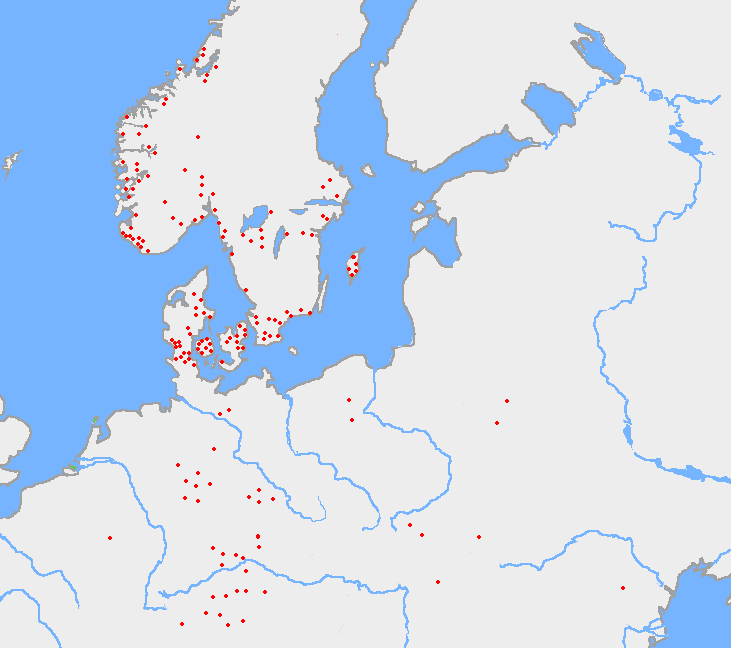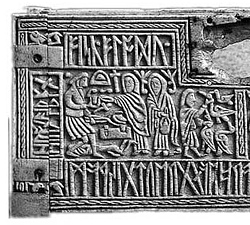|
Algiz
Algiz (also Elhaz) is the name conventionally given to the "''z''-rune" of the Elder Futhark runic alphabet. Its transliteration is ''z'', understood as a phoneme of the Proto-Germanic language, the terminal ''*z'' continuing Proto-Indo-European language, Proto-Indo-European terminal ''*s'' via Verner's law. It is one of two runes which express a phoneme that does not occur word-initially, and thus could not be named Acrophony, acrophonically, the other being the ''ŋ''-rune Ingwaz rune, Ingwaz . As the terminal ''*-z'' phoneme marks the nominative singular suffix of masculine nouns, the rune occurs comparatively frequently in Elder Futhark inscriptions, early epigraphy. Because this specific phoneme was lost at an early time, the Elder Futhark rune underwent changes in the medieval runic alphabets. In the Anglo-Saxon runes, Anglo-Saxon futhorc it retained its shape, but became otiose as it ceased to represent any sound in an Old English. However, possibly due to runic manuscr ... [...More Info...] [...Related Items...] OR: [Wikipedia] [Google] [Baidu] |
Elder Futhark
The Elder Futhark (or Fuþark, ), also known as the Older Futhark, Old Futhark, or Germanic Futhark, is the oldest form of the runic alphabets. It was a writing system used by Germanic peoples for Northwest Germanic dialects in the Migration Period. Inscriptions are found on artifacts including jewelry, amulets, plateware, tools, and weapons, as well as runestones, from the 2nd to the 8th centuries. In Scandinavia, beginning in the late 8th century, the script was simplified to the Younger Futhark, while the Anglo-Saxons and Frisians instead extended it, giving rise to the Anglo-Saxon runes, Anglo-Saxon futhorc. Both the Anglo-Saxon futhorc and the Younger Futhark remained in use during the Early Middle Ages, Early and the High Middle Ages respectively, but knowledge of how to read the Elder Futhark was forgotten until 1865, when it was deciphered by Norwegian scholar Sophus Bugge. Description The Elder Futhark is named after the initial phoneme of the first six rune names: /f/ ... [...More Info...] [...Related Items...] OR: [Wikipedia] [Google] [Baidu] |
Ur (rune)
Ur is the recorded name for the Runes, rune in both Old English and Old Norse, found as the second rune in all futharks (runic alphabets starting with F, U, Þ, Ą, R, K), i.e. the Elder Futhark, Germanic Elder Futhark, the Anglo-Saxon runes, Anglo-Frisian Futhark and the Younger Futhark, Norse Younger Futhark, with continued use in the later medieval runes, early modern runes and Dalecarlian runes. It corresponds to the letter u in the Latin alphabet, but also carries other sound values, especially in Younger Futhark, were its sound values correspond to the vowels: , , and etc., and the consonants: and etc., in the Latin alphabet. Character The character ᚢ may have been derived from the Old Italic scripts, as such features various characters corresponding to Elder Futhark, elder runes, including both upside and downside characters for Upsilon (/u, y/): , , specifically the Rhaetic, East Rhaetic alphabet from the Magrè-region of north-east Italy, which primarily used t ... [...More Info...] [...Related Items...] OR: [Wikipedia] [Google] [Baidu] |
Anglo-Saxon Runes
Anglo-Saxon runes or Anglo-Frisian runes are runes that were used by the Anglo-Saxons and Medieval Frisians (collectively called Anglo-Frisians) as an alphabet in their native writing system, recording both Old English and Old Frisian (, ᚱᚢᚾᚪ, "rune"). Today, the characters are known collectively as the futhorc (ᚠᚢᚦᚩᚱᚳ, ''fuþorc'') from the sound values of the first six runes. The futhorc was a development from the older Germanic peoples, co-Germanic 24-character runic alphabet, known today as Elder Futhark, expanding to 28 characters in its older form and up to 34 characters in its younger form. In contemporary Scandinavia, the Elder Futhark developed into a shorter 16-character alphabet, today simply called Younger Futhark. Use of the Anglo-Frisian runes is likely to have started in the 5th century onward and they continued to see use into the High Middle Ages. They were later accompanied and eventually overtaken by the Old English Latin alphabet introdu ... [...More Info...] [...Related Items...] OR: [Wikipedia] [Google] [Baidu] |
Moose
The moose (: 'moose'; used in North America) or elk (: 'elk' or 'elks'; used in Eurasia) (''Alces alces'') is the world's tallest, largest and heaviest extant species of deer and the only species in the genus ''Alces''. It is also the tallest, and the second-largest, land animal in North America, falling short only to the American bison in body mass. Most adult male moose have broad, palmate ("open-hand shaped") antlers; other members of the deer family have pointed antlers with a dendritic ("twig-like") configuration. Moose inhabit the circumpolar boreal forests or temperate broadleaf and mixed forests of the Northern Hemisphere, thriving in cooler, temperate areas as well as subarctic climates. Hunting shaped the relationship between moose and humans, both in Eurasia and North America. Prior to the colonial era (around 1600–1700 CE), moose were one of many valuable sources of sustenance for certain tribal groups and First Nations. Hunting and habitat loss hav ... [...More Info...] [...Related Items...] OR: [Wikipedia] [Google] [Baidu] |
Ingwaz Rune
Old Norse Yngvi , Old High German Ing/Ingwi and Old English Ing are names that relate to a theonym which appears to have been the older name for the god Freyr. Proto-Germanic Ingwaz was the legendary ancestor of the Ingaevones, or more accurately ''Ingvaeones'', and is also the reconstructed name of the Elder Futhark rune ᛜ and Anglo-Saxon rune ᛝ, representing '' ŋ''. Etymology Old Norse ''Yngvi'' as well as Old High German ''Inguin'' and Old English ''Ingƿine'' are all derived from the Proto-Germanic *Ingwaz. Sound changes in late-Proto-Germanic transformed *Ingwaz into *Ingwi(z) in the nominative case and *''Ingwin'' in the accusative case. His epithet * Fraujaz appears in Old Norse compounds ''Ingvifreyr'' and ''Ingunarfreyr''. In Beowulf we see Hrothgar called (OE) ''fréa inguina'', which means 'Lord of the Inguins', i.e. lord of the Ingvaeones, the 'friends of Ing'. This strongly indicates that the two deities, Ing and Freyr are indeed the same. However, it is also ... [...More Info...] [...Related Items...] OR: [Wikipedia] [Google] [Baidu] |
Common Germanic
Proto-Germanic (abbreviated PGmc; also called Common Germanic) is the reconstructed proto-language of the Germanic branch of the Indo-European languages. Proto-Germanic eventually developed from pre-Proto-Germanic into three Germanic branches during the fifth century BC to fifth century AD: West Germanic, East Germanic and North Germanic. North Germanic remained in contact with the other branches over a considerable time, especially with the Ingvaeonic languages (including English), which arose from West Germanic dialects, and had remained in contact with the Norse. A defining feature of Proto-Germanic is the completion of the process described by Grimm's law, a set of sound changes that occurred between its status as a dialect of Proto-Indo-European and its gradual divergence into a separate language. The end of the Common Germanic period is reached with the beginning of the Migration Period in the fourth century AD. The alternative term " Germanic parent lang ... [...More Info...] [...Related Items...] OR: [Wikipedia] [Google] [Baidu] |
Rhaetic Alphabets
The Old Italic scripts are a family of ancient writing systems used in the Italian Peninsula between about 700 and 100 BC, for various languages spoken in that time and place. The most notable member is the Etruscan alphabet, which was the immediate ancestor of the Latin alphabet used by more than 100 languages today, including English. The runic alphabets used in Northern Europe are believed to have been separately derived from one of these alphabets by the 2nd century AD. Origins The Old Italic alphabets ultimately derive from the Phoenician alphabet, but the general consensus is that the Etruscan alphabet was imported from the Euboean Greek colonies of Cumae and Ischia (Pithekoūsai) situated in the Gulf of Naples in the 8th century BC; this Euboean alphabet is also called 'Cumaean' (after Cumae), or 'Chalcidian' (after its metropolis Chalcis). The Cumaean hypothesis is supported by the 1957–58 excavations of Veii by the British School at Rome, which found pieces of Gr ... [...More Info...] [...Related Items...] OR: [Wikipedia] [Google] [Baidu] |
History Of The Latin Alphabet
The Latin script is the most widely used alphabet, alphabetic writing system in the world. It is the standard script of the English language and is often referred to simply as "the alphabet" in English. It is a true alphabet which originated in the 7th century BC in Italy and has changed continually over the last 2,500 years. It has roots in the Semitic alphabet and its offshoot alphabets, the Phoenician alphabet, Phoenician, Greek alphabet, Greek, and Etruscan alphabet, Etruscan. The phonetic values of some letters Latin spelling and pronunciation, changed, some letters were lost and gained, and several writing styles ("hands") developed. Two such styles, the minuscule cursive, minuscule and majuscule hands, were combined into one script with alternate forms for the lower and upper Letter case, case letters. Modern uppercase letters differ only slightly from their classical counterparts, and there are few regional variants. Summary of evolution The Latin alphabet started out as u ... [...More Info...] [...Related Items...] OR: [Wikipedia] [Google] [Baidu] |
Western Greek Alphabet
Many local variants of the Greek alphabet were employed in ancient Greece during the Archaic Greece, archaic and Classical Greece, early classical periods, until around 400 BC, when they were replaced by the classical 24-letter alphabet that is the standard today. All forms of the Greek alphabet were originally based on the shared inventory of the 22 symbols of the Phoenician alphabet, with the exception of the letter Samekh, whose Greek counterpart Xi (letter), Xi () was used only in a subgroup of Greek alphabets, and with the common addition of Upsilon () for the vowel . The local, so-called ''epichoric'', alphabets differed in many ways: in the use of the consonant symbols , and ; in the use of the innovative long vowel letters ( and ), in the absence or presence of Η in its original consonant function (); in the use or non-use of certain archaic letters ( = , = , = ); and in many details of the individual shapes of each letter. The system now familiar as the standa ... [...More Info...] [...Related Items...] OR: [Wikipedia] [Google] [Baidu] |
Old Italic Alphabets
The Old Italic scripts are a family of ancient writing systems used in the Italian Peninsula between about 700 and 100 BC, for various languages spoken in that time and place. The most notable member is the Etruscan alphabet, which was the immediate ancestor of the Latin alphabet used by more than 100 languages today, including English. The runic alphabets used in Northern Europe are believed to have been separately derived from one of these alphabets by the 2nd century AD. Origins The Old Italic alphabets ultimately derive from the Phoenician alphabet, but the general consensus is that the Etruscan alphabet was imported from the Euboean Greek colonies of Cumae and Ischia (Pithekoūsai) situated in the Gulf of Naples in the 8th century BC; this Euboean alphabet is also called 'Cumaean' (after Cumae), or 'Chalcidian' (after its metropolis Chalcis). The Cumaean hypothesis is supported by the 1957–58 excavations of Veii by the British School at Rome, which found pie ... [...More Info...] [...Related Items...] OR: [Wikipedia] [Google] [Baidu] |
Retroflex Approximant
The voiced retroflex approximant is a type of consonant used in some languages. The symbol in the International Phonetic Alphabet that represents this sound is , and the equivalent X-SAMPA symbol is r\`. The IPA symbol is a turned lowercase letter ''r'' with a rightward hook protruding from the lower right of the letter. The velar bunched approximant found in some varieties of Dutch language, Dutch and American English sounds similar to the retroflex approximant but it has a very different articulation. Features ] Features of the voiced retroflex approximant: Occurrence See also * Alveolar approximant * Retroflex consonant * R-colored vowel * Index of phonetics articles Notes References * * * * External links * {{LetterR Retroflex consonants Pulmonic consonants Oral consonants Central consonants ... [...More Info...] [...Related Items...] OR: [Wikipedia] [Google] [Baidu] |




